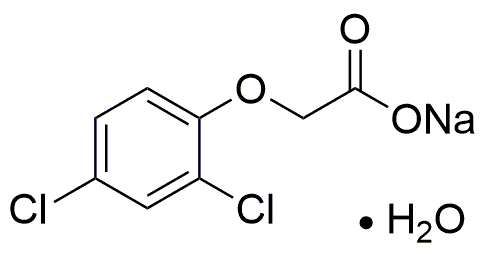Sodium 2,4-dichlorophenoxyacetate monohydrate is widely utilized in research focused on:
- Agricultural Herbicides: This compound serves as an effective herbicide, particularly in controlling broadleaf weeds in various crops. Its selective action minimizes damage to crops, making it a preferred choice for farmers.
- Plant Growth Regulation: It is used to regulate plant growth by influencing hormone levels, helping in the development of desired traits in crops, such as increased yield or resistance to environmental stress.
- Environmental Studies: Researchers employ this chemical to study its effects on ecosystems, particularly in assessing the impact of herbicides on non-target species and soil health.
- Laboratory Research: In biochemistry and molecular biology labs, it is utilized to investigate plant responses to herbicides, aiding in the development of more sustainable agricultural practices.
- Formulation Development: The compound is also critical in the formulation of various agricultural products, ensuring stability and effectiveness in herbicide applications.
Informations générales
Propriétés
Sécurité et réglementation
Applications
Sodium 2,4-dichlorophenoxyacetate monohydrate is widely utilized in research focused on:
- Agricultural Herbicides: This compound serves as an effective herbicide, particularly in controlling broadleaf weeds in various crops. Its selective action minimizes damage to crops, making it a preferred choice for farmers.
- Plant Growth Regulation: It is used to regulate plant growth by influencing hormone levels, helping in the development of desired traits in crops, such as increased yield or resistance to environmental stress.
- Environmental Studies: Researchers employ this chemical to study its effects on ecosystems, particularly in assessing the impact of herbicides on non-target species and soil health.
- Laboratory Research: In biochemistry and molecular biology labs, it is utilized to investigate plant responses to herbicides, aiding in the development of more sustainable agricultural practices.
- Formulation Development: The compound is also critical in the formulation of various agricultural products, ensuring stability and effectiveness in herbicide applications.
Documents
Fiches de données de sécurité (FDS)
La FDS fournit des informations de sécurité complètes sur la manipulation, le stockage et l’élimination du produit.
Spécifications du produit (PS)
Le PS fournit une description complète des propriétés du produit, notamment sa composition chimique, son état physique, sa pureté et les exigences de stockage. Il détaille également les plages de qualité acceptables et les applications prévues du produit.
Certificats d'analyse (COA)
Recherchez des certificats d'analyse (COA) en saisissant le numéro de lot du produit. Les numéros de lot et de lot se trouvent sur l'étiquette d'un produit, après les mots « Lot » ou « Lot de fabrication ».
Numéro de catalogue
Numéro de lot/série
Certificats d'origine (COO)
Ce certificat d'exploitation confirme le pays dans lequel le produit a été fabriqué, et détaille également les matériaux et composants utilisés et s'il est issu de sources naturelles, synthétiques ou autres sources spécifiques. Ce certificat peut être requis pour les douanes, le commerce et la conformité réglementaire.
Numéro de catalogue
Numéro de lot/série
Fiches de données de sécurité (FDS)
La FDS fournit des informations de sécurité complètes sur la manipulation, le stockage et l’élimination du produit.
DownloadSpécifications du produit (PS)
Le PS fournit une description complète des propriétés du produit, notamment sa composition chimique, son état physique, sa pureté et les exigences de stockage. Il détaille également les plages de qualité acceptables et les applications prévues du produit.
DownloadCertificats d'analyse (COA)
Recherchez des certificats d'analyse (COA) en saisissant le numéro de lot du produit. Les numéros de lot et de lot se trouvent sur l'étiquette d'un produit, après les mots « Lot » ou « Lot de fabrication ».
Numéro de catalogue
Numéro de lot/série
Certificats d'origine (COO)
Ce certificat d'exploitation confirme le pays dans lequel le produit a été fabriqué, et détaille également les matériaux et composants utilisés et s'il est issu de sources naturelles, synthétiques ou autres sources spécifiques. Ce certificat peut être requis pour les douanes, le commerce et la conformité réglementaire.


